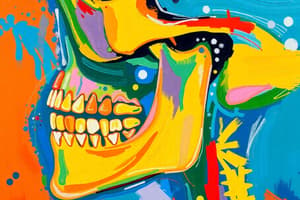Podcast
Questions and Answers
During intra-auricular palpation, which structure can be palpated with the pulp of the little finger?
During intra-auricular palpation, which structure can be palpated with the pulp of the little finger?
- Lateral pole of the condyle
- Posterior pole of the condylar head (correct)
- Medial pole of the condyle
- Anterior pole of the condyle
What is the characteristic of a 'click' joint sound?
What is the characteristic of a 'click' joint sound?
- Continuous grating noise
- High-pitched noise
- Single explosive noise of short duration (correct)
- Low-pitched noise
Which muscle is NOT examined during clinical evaluation of muscles of mastication?
Which muscle is NOT examined during clinical evaluation of muscles of mastication?
- Temporalis
- Masseter
- Buccinator (correct)
- Medial Pterygoid
What is the purpose of the joint compression test?
What is the purpose of the joint compression test?
Which special test is used to evaluate the joint capsule and ligaments?
Which special test is used to evaluate the joint capsule and ligaments?
What is the primary cause of tenderness to muscles of mastication?
What is the primary cause of tenderness to muscles of mastication?
How is the lateral pterygoid muscle palpated?
How is the lateral pterygoid muscle palpated?
What is the purpose of resisted isometric muscle testing?
What is the purpose of resisted isometric muscle testing?
What is the normal range of maximum opening distance between the incisal edges of upper and lower incisors?
What is the normal range of maximum opening distance between the incisal edges of upper and lower incisors?
What is the normal lateral range of movement in the TMJ?
What is the normal lateral range of movement in the TMJ?
What is the main goal of Post Isometric Relaxation technique in treating TMD disorders?
What is the main goal of Post Isometric Relaxation technique in treating TMD disorders?
What is the primary purpose of using a splint in Temporary Occlusal Therapy?
What is the primary purpose of using a splint in Temporary Occlusal Therapy?
What is the recommended technique for treating unilateral anterior displacement of the articular disc with adhesion to the articular eminence?
What is the recommended technique for treating unilateral anterior displacement of the articular disc with adhesion to the articular eminence?
What is the primary focus of Posture correction in TMD treatment?
What is the primary focus of Posture correction in TMD treatment?
What is the primary purpose of Trigger Point Pressure Release in TMD treatment?
What is the primary purpose of Trigger Point Pressure Release in TMD treatment?
What is the recommended management strategy for patients with stress-related TMD?
What is the recommended management strategy for patients with stress-related TMD?
What is the primary goal of the 6x6 Exercise protocol of Rocabado?
What is the primary goal of the 6x6 Exercise protocol of Rocabado?
What is the recommended treatment for patients with pain and stiffness in the TMJ on awakening?
What is the recommended treatment for patients with pain and stiffness in the TMJ on awakening?
Flashcards are hidden until you start studying
Study Notes
Treatment of TMD
- Acute stage treatment involves the 6x6 Exercise protocol of Rocabado, Cork exercise, and Tongue positioning during mouth opening and closing.
- Trigger Point Pressure Release involves applying pressure to the trigger point, increasing pressure as it releases and softens.
- Post Isometric Relaxation technique restores decreased range of motion by stretching and providing resistance.
- Manipulation-Mobilization involves treating unilateral anterior displacement of the articular disc with adhesion to the articular eminence using a low-amplitude high-velocity thrust.
- TMJ mobilization is performed to tear joint capsule adhesions and realign collagen fibers.
- Posture correction involves training for the neck, back, shoulder, and tongue to achieve optimal physiological state.
- Temporary Occlusal Therapy uses splints to prevent the upper and lower teeth from coming together, reducing pressure on the jaw joints and muscles.
Recommendations for TMD Patients
- Manage stress by identifying stressors and making a plan to reduce and manage them.
- Avoid opening mouth wide and moving excessively from one side to another.
Common Disorders of TMJ
Myogenic Disorders
- Myofascial pain
- Myofibrotic contracture
- Myospasm
- Neoplasia
Articular Disorders
- Congenital or developmental disorders
- Disk derangement disorders
- Fracture of the condylar process
- Inflammatory disorders
- Osteoarthritis
- TMJ dislocation
Signs and Symptoms of TMD
- Pain
- Impaired jaw function
- Malocclusion
- Deviation with/without correction
- Limited range of motion
- Joint noise and locking
- Headache, tinnitus, visual changes, and other neurologic complaints
Clinical Examination of TMJ
Inspection
- Maximum opening distance between the incisal edges of upper and lower incisors is 40-55 mm
- Normal opening can be estimated by patient's own finger (three finger end on end)
- Lateral range of movement is >7 mm
Palpation
- Intra-auricular palpation can be achieved by placing a little finger inside the external auditory meatus
- Extra auricular examination of TMJ is done by placing index finger in the pre-auricular region
Joint Sounds
- Clicks: single explosive noise of short duration
- Crepitus: continuous 'grating' noise
Range of Motion
- Clinical evaluation of muscles of mastication is essential for TMD patients
- Tenderness to muscles of mastication results from stress and fatigue
Muscles of Mastication to be Examined
- Masseter
- Temporalis
- Medial Pterygoid
- Lateral Pterygoid
Palpation of Specific Muscles
- Temporal muscle: palpate multiple areas
- Masseter muscle: palpate multiple areas
- Lateral Pterygoid muscle: palpate by using the little or index finger and placing it lateral to maxillary tuberosity and medial to coronoid process
Special Tests
- Joint compression test: manually loading the intraarticular structures
- Joint distraction test: evaluating the joint capsule and ligaments
- Resisted isometric muscle testing: pain or weakness may be elicited in the presence of muscle problems
Studying That Suits You
Use AI to generate personalized quizzes and flashcards to suit your learning preferences.




